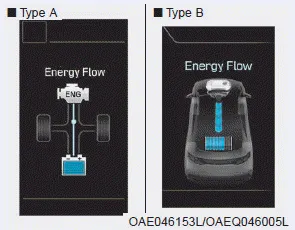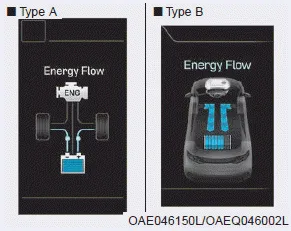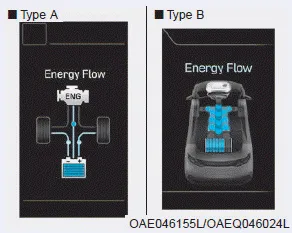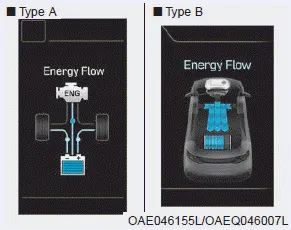Hyundai Ioniq (AE): Driving the Hybrid/Plug-in Hybrid Vehicle / Energy flow
The hybrid system informs the drivers its energy flow in various operating modes. While driving, the current energy flow is specified in 11 modes.
Vehicle Stop

The vehicle is stopped. (No energy flow)
EV Propulsion

Only the motor power is used to drive the vehicle.
(Battery ➞ Wheel)
Power Assist

Both the motor and the engine power are used to drive the vehicle.
(Battery & Energy ➞ Wheel)
Engine Only Propulsion

Only the engine power is used to drive the vehicle.
(Engine ➞ Wheel)
Engine Generation

When the vehicle is stopped, the high-voltage battery is charged up by the engine.
(Engine ➞ Battery)
Regeneration

The high-voltage battery is charged up by the regenerative brake system.
(Wheel ➞ Battery)
Engine Brake

The engine braking is used to decelerate the vehicle.
(Wheel ➞ Engine)
Power Reserve

The engine is simultaneously used to drive the vehicle and to charge up the high-voltage battery.
(Engine ➞ Wheel & Battery)
Engine Generation/Motor Drive

The engine charges up the high-voltage battery. The motor power is used to drive the vehicle.
(Engine ➞ Battery ➞ Wheel)
Engine Generation/Regeneration

The engine and regenerative brake system charges up the high-voltage battery.
(Engine & Wheel ➞ Battery)
Engine Brake/Regeneration

The engine braking is simultaneously used to decelerate the vehicle and to charge up the high-voltage battery.
(Wheel ➞ Engine & Battery)
Check Hybrid system This message is displayed when there is a problem with the hybrid control system. Refrain from driving when the warning message is displayed.
Other information:
Hyundai Ioniq (AE) 2017-2022 Service & Repair Manual: Evaporator Temperature Sensor. Description and operation
DescriptionThe evaporator temperature sensor will detect the evaporator core temperature and interrupt compressor relay power in order to prevent evaporator from freezing by excessive cooling. The evaporator temperature sensor has the Negative Temperature Coefficient (NTC).
Hyundai Ioniq (AE) 2017-2022 Service & Repair Manual: Heater Unit. Components and components location
Component Location1. Heater unit assemblyCompoents1. Heater core cover2. Heater core & Seal assembly3. Mode actuator [LH]4. Temperature control actuator [LH]5. Shower duct [LH]6. Duct sensor [Floor]7. PTC Heater8. Duct sensor [Vent]9. Heater & Evaporator lower case10.
Categories
- Manuals Home
- Hyundai Ioniq Owners Manual
- Hyundai Ioniq Service Manual
- Cruise Control Switch. Repair procedures
- Parking Distance Warning system (Reverse) malfunction, Check Active Air Flap System
- Repair procedures
- New on site
- Most important about car
